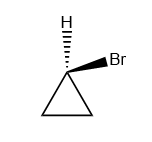A classmate an I were discussing the chirality of this molecule which is a monosubsituted cyclopropane. I argue this is an achiral molecule because that carbon which is bonded to bromine cannot be a stereocenter. If you try to determine a point of difference between the other two "substituents," there is none. But if you draw a mirror image, it appears to be non-superimposable which is a trademark of chiral molecules. Is my reasoning on the right track, or is there something unique about the chiral or achiral nature of cyclopropanes such as these.
2 Answers
Here is a 3-D conformer from PubChem
As you can clearly see, a plane of symmetry can be sent along the black line perpendicular to the plane of the screen. Hence, the molecule is achiral. If you take a mirror image, you can ultimately super-impose it again on the parent form
Here is an illustrative 3D image(courtesy of andselisk) which clearly shows the plane of symmetry in pink and ring plane in blue.
It is achiral. The cyclopropane ring is planar. The substituted C will be $\mathrm{sp^3}$ hybridised (tetrahedral). If you consider two of the C's in one plane and the H and Br in the other plane, these two planes will make 90° angle between them and one can draw a mirror plane along the plane containing H and Br. Thus, it will be achiral.
-
2$\begingroup$ Note: every 3-atom ring must be planar no matter what else is on it, because 3 points define a plane $\endgroup$– llamaCommented Nov 25, 2019 at 20:58
-
$\begingroup$ Nit-pick - 3 non co-linear points define a plane. That said I once lost marks during my degree in an organic chemistry piece of work for this very explantation of the planarity of the carbons in cyclo-propanes as the tutor didn't understand my comment. $\endgroup$– Ian BushCommented Nov 26, 2019 at 13:05



